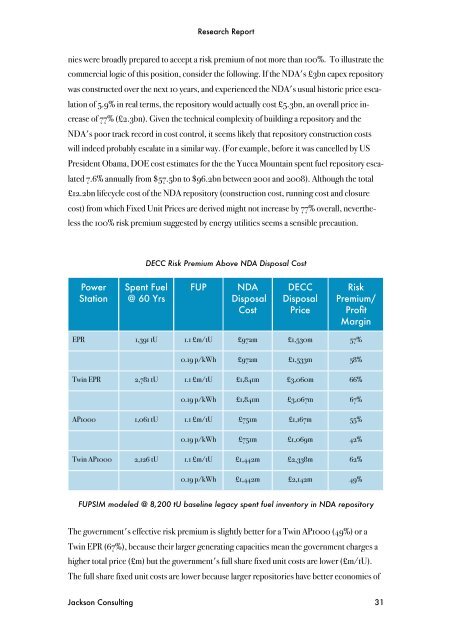fixed unit price simulation for disposal of spent fuel ... - Greenpeace UK
fixed unit price simulation for disposal of spent fuel ... - Greenpeace UK
fixed unit price simulation for disposal of spent fuel ... - Greenpeace UK
You also want an ePaper? Increase the reach of your titles
YUMPU automatically turns print PDFs into web optimized ePapers that Google loves.
Research Report<br />
nies were broadly prepared to accept a risk premium <strong>of</strong> not more than 100%. To illustrate the<br />
commercial logic <strong>of</strong> this position, consider the following. If the NDA's £3bn capex repository<br />
was constructed over the next 10 years, and experienced the NDA's usual historic <strong>price</strong> escalation<br />
<strong>of</strong> 5.9% in real terms, the repository would actually cost £5.3bn, an overall <strong>price</strong> increase<br />
<strong>of</strong> 77% (£2.3bn). Given the technical complexity <strong>of</strong> building a repository and the<br />
NDA's poor track record in cost control, it seems likely that repository construction costs<br />
will indeed probably escalate in a similar way. (For example, be<strong>for</strong>e it was cancelled by US<br />
President Obama, DOE cost estimates <strong>for</strong> the the Yucca Mountain <strong>spent</strong> <strong>fuel</strong> repository escalated<br />
7.6% annually from $57.5bn to $96.2bn between 2001 and 2008). Although the total<br />
£12.2bn lifecycle cost <strong>of</strong> the NDA repository (construction cost, running cost and closure<br />
cost) from which Fixed Unit Prices are derived might not increase by 77% overall, nevertheless<br />
the 100% risk premium suggested by energy utilities seems a sensible precaution.<br />
DECC Risk Premium Above NDA Disposal Cost<br />
Power<br />
Station<br />
Spent Fuel<br />
@ 60 Yrs<br />
FUP<br />
NDA<br />
Disposal<br />
Cost<br />
DECC<br />
Disposal<br />
Price<br />
Risk<br />
Premium/<br />
Pr<strong>of</strong>it<br />
Margin<br />
EPR 1,391 tU 1.1 £m/tU £972m £1,530m 57%<br />
0.19 p/kWh £972m £1,533m 58%<br />
Twin EPR 2,781 tU 1.1 £m/tU £1,841m £3,060m 66%<br />
0.19 p/kWh £1,841m £3,067m 67%<br />
AP1000 1,061 tU 1.1 £m/tU £751m £1,167m 55%<br />
0.19 p/kWh £751m £1,069m 42%<br />
Twin AP1000 2,126 tU 1.1 £m/tU £1,442m £2,338m 62%<br />
0.19 p/kWh £1,442m £2,142m 49%<br />
FUPSIM modeled @ 8,200 tU baseline legacy <strong>spent</strong> <strong>fuel</strong> inventory in NDA repository<br />
The government's effective risk premium is slightly better <strong>for</strong> a Twin AP1000 (49%) or a<br />
Twin EPR (67%), because their larger generating capacities mean the government charges a<br />
higher total <strong>price</strong> (£m) but the government's full share <strong>fixed</strong> <strong>unit</strong> costs are lower (£m/tU).<br />
The full share <strong>fixed</strong> <strong>unit</strong> costs are lower because larger repositories have better economies <strong>of</strong><br />
Jackson Consulting 31




![[2007] EWHC 311 - Greenpeace UK](https://img.yumpu.com/22079793/1/184x260/2007-ewhc-311-greenpeace-uk.jpg?quality=85)












